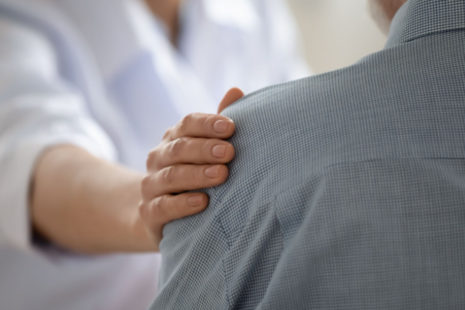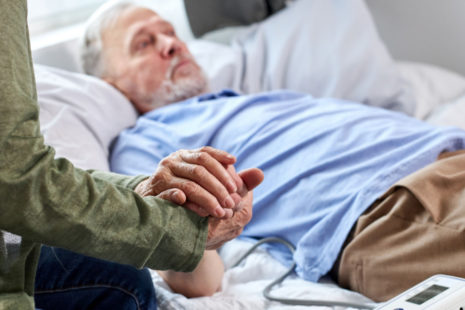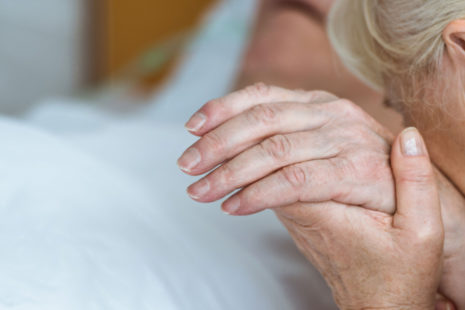Arthritis is a condition that causes inflammation, swelling, discomfort, and pain in one or more joints. There are several different forms of arthritis, including lupus, fibromyalgia, and gout. However, the most common arthritis types include rheumatoid arthritis (an inflammatory form of arthritis) and osteoarthritis (a non-inflammatory form of arthritis). These two types of arthritis damage joints in different ways. Severe arthritis may impair your ability to perform daily tasks, sit or walk comfortably.
What Causes Joint Pain in Seniors?
Pain in joins in seniors is typically a result of arthritis, a musculoskeletal disease that causes inflammation, stiffness, and pain in joints.
What are the Common Causes of Arthritis?
The risk of arthritis increases with age, and it is more common in women than men. Around 26 percent of women in the U.S. have some form of arthritis compared to 19 percent of men diagnosed with this disorder. Also, a family history of arthritis and previous joint injuries may increase your risk of developing the condition later in life.
How to Recognize the Early Signs of Arthritis?
The symptoms of arthritis vary depending on the type of arthritis. However, the most common early signs of arthritis in the elderly include:
- Tenderness and stiffness in the joints
- Joint pain
- Reduced mobility of the affected joints
- Inflammation around and in the affected joints
- Skin redness over the joint
What Percentage of Seniors Have Arthritis?
For many aging adults, arthritis is something that happens daily, affecting one’s ability to do daily tasks and perform basic activities of daily living (ADLs). According to the Centers for Disease Control and Prevention reports, almost half of all people aged 65 years or older in the United States have doctor-diagnosed arthritis.
Along with age, obesity can play a role in arthritis, as people with higher weights are more likely to suffer from arthritis.
What Type of Arthritis is Most Common in the Elderly?
Osteoarthritis is the most common type of arthritis among the elderly. According to the Arthritis Foundation, 31 million people in the United States experiences osteoarthritis.
This is the most common type of arthritis in general, and it involves wear-and-tear damage to your joints, caused by bones rubbing together. It affects the entire joint and causes deterioration of the joint’s cartilage – the coating on the end of the bone that forms a joint and allows movements. The cartilage begins to erode, affecting the underlying bones, causing you to feel pain, swelling, and stiffness. In most severe forms, osteoarthritis causes disability and stops you from working and doing daily tasks.
Osteoarthritis leads to damage that results in bones grinding directly on one another, which causes pain, inflammation, swelling, and limited mobility. It mostly occurs in hands, hips, and knees and may develop over many years or fast-tracked by a joint infection or injury.
The risk of developing osteoarthritis increases with age, and it affects women more often than men. The main symptoms of osteoarthritis involve stiffness and swelling of joints, pain, and reduced flexibility and mobility.
How Does Arthritis Affect the Elderly?
Rheumatoid arthritis and osteoarthritis in the elderly cause chronic pain and limited movements, resulting in irritability, anxiety, depression, sleep disturbances, and more.
According to the Arthritis Foundation, 23.7 million adults in the U.S. report that arthritis restricts their mobility, preventing them from performing day-to-day activities, enjoying hobbies, and limiting their ability to take care of themselves.
For example, if you enjoyed painting, your arthritic hands and fingers may now make it difficult to keep up your hobby. Physically active people may find it hard to adjust to limited mobility and pain caused by their condition.
Also, many older adults lose their jobs and experience financial hardship due to osteoarthritis. The Arthritis Foundation reports that this form of arthritis is the leading cause of work loss in the country.
However, this doesn’t mean that arthritis should stop you from active living. Exercises that help build up the muscles around the joints can reduce pain and improve mobility. Stretching and a variety of strength and motion workouts have proven to alleviate arthritis symptoms in seniors effectively. Nevertheless, it would be best to discuss your condition with your health provider to determine whether physical activity would benefit you.
What are the Five Foods to Eat If You Have Arthritis?
Rheumatoid arthritis is inflammation, so you should avoid foods that increase inflammation. The five foods to eat if you have arthritis are:
- Gluten-containing foods. There is a strong correlation between celiac disease and rheumatoid arthritis, so gluten-rich foods should not be on your shopping list if you have arthritis.
- Trans Fats. You should avoid food with a high concentration of trans fats as they can aggravate inflammation in your joints and aggravate rheumatoid arthritis. Trans fats are found in most processed food like fast food, cookies, crackers, and similar.
- Fried and Processed Foods. Frying destroys most of the nutrients in fried foods, and it can contribute to inflammation and arthritis risk factors such as obesity. Besides, heavily processed and fried foods also pose a high risk of heart disease and diabetes and contain many carcinogens.
- White Sugar and Refined Carbs. Added sugars in soda, candies, sauces, and many other foods may significantly risk getting arthritis or worsen the symptoms as they exacerbate inflammation.
- Red and Processed Meats. Research shows that red and heavily processed meats increase inflammation, which may worsen rheumatoid arthritis symptoms.
Conversely, foods rich in proteins, vitamins, fiber, antioxidants, and minerals such as nuts, beans, citrus fruits, and green tea are foods to pursue if you struggle with arthritis.
What is the Most Common Type of Arthritis?
Most people suffer from osteoarthritis, the progressive tear-and-wear that affects joint cartilage. Cartilage becomes less elastic and loses its ability to cushion the bone’s rubbing against bone, causing pain, stiffness, and reduced mobility.
Rheumatoid arthritis is an autoimmune inflammatory disease that causes the body to attack itself. You can recognize it by sharp joint pain, swelling, and deformity of fingers, wrists, and feet.
What Causes Stiffness in the Elderly?
Most elderly with arthritis complain about pain and stiffness in their fingers, knees, hips, and spine that occurs due to osteoarthritis that leads to joint cartilage.
Is Arthritis Inevitable in Old Age?
Most people over the age of 65 have some form of arthritis. Even though age is one of the main risk factors for this condition, arthritis is not inevitable in old age.
How Can I Avoid Getting Arthritis?
It is not always possible to prevent arthritis as some risk factors such as genetics and increasing age are impossible to control. However, there are some healthy habits you can practice to reduce the risk of getting arthritis. To avoid developing arthritis as you age, keep a healthy weight, control your blood sugar, exercise regularly, and eat fish twice a week. Also, stay away from alcohol and smoking and avoid injuries as much as possible.
How Can I Stop Joint Pain?
Arthritis is a degenerative condition, which means that symptoms typically worsen over time. To alleviate pain, rest your joints as much as you can, and avoid any activities that trigger pain. When sitting or lying, elevate the painful joint above the level of your heart. It can also help if you protect the affected joint with an elastic wrap or a brace.
Can Arthritis be Cured?
There is no cure for arthritis. However, various treatments can help slow down the progression of the disease and alleviate the symptoms.
How Do You Treat Arthritis in the Elderly?
Arthritis treatment involves strategies to relieve symptoms and improve joint mobility and flexibility. There is a variety of treatments available, and it depends on your specific condition, which ones will work for you.
Most common arthritis therapies involve medications, physical therapy, and surgery. There are also various home remedies, alternative treatments, and lifestyle changes that you can try out.
- Medications
Your doctor may prescribe different medications depending on the type of arthritis you have. Most widely used arthritis medications include painkillers, nonsteroidal anti-inflammatory drugs (NSAIDs), disease-modifying antirheumatic drugs (DMARDs), corticosteroids, counterirritants, and biologic response modifiers.
- Physical Therapy
Exercises can help some forms of arthritis, strengthening the muscles around the joints, and improving joint mobility and flexibility.
- Surgery
If you suffer from a severe form of arthritis, your doctor may suggest surgery. These procedures may involve joint repair, replacement, or fusion.
- Alternative Treatments and Lifestyle Changes
Alternative medicine can improve arthritis symptoms in some people. Although alternative remedies’ effectiveness is scarcely backed-up by scientific evidence, most people decide to try alternative treatments such as acupuncture, massage, yoga, tai chi, and glucosamine.
Also, many people can alleviate arthritis symptoms with lifestyle changes, such as the following:
Exercise and yoga. Stretching yoga movements and exercises, swimming, water aerobics, strength, and motion workouts can help keep joints flexible.
Healthy diet. Obesity is one of the leading risk factors for arthritis. Losing weight can reduce pressure on your joints, improve mobility, and prevent future deterioration.
Massage. Light massage can increase blood flow, warming the joints, and temporarily relieving pain.







